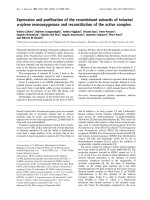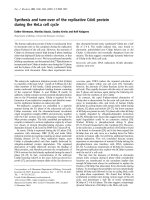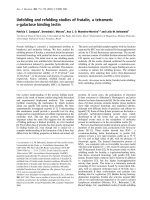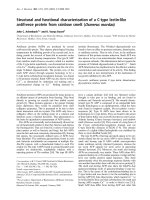Báo cáo y học: " Derivation and preliminary validation of an administrative claims-based algorithm for the effectiveness of medications for rheumatoid arthritis"
Bạn đang xem bản rút gọn của tài liệu. Xem và tải ngay bản đầy đủ của tài liệu tại đây (241.42 KB, 29 trang )
This Provisional PDF corresponds to the article as it appeared upon acceptance. Copyedited and
fully formatted PDF and full text (HTML) versions will be made available soon.
Derivation and preliminary validation of an administrative claims-based
algorithm for the effectiveness of medications for rheumatoid arthritis
Arthritis Research & Therapy 2011, 13:R155 doi:10.1186/ar3471
Jeffrey R Curtis ()
John W Baddley ()
Shuo Yang ()
Nivedita Patkar ()
Lang Chen ()
Elizabeth Delzell ()
Ted R Mikuls ()
Kenneth G Saag ()
Jasvinder Singh ()
Monika Safford ()
Grant W Cannon ()
ISSN 1478-6354
Article type Research article
Submission date 22 March 2011
Acceptance date 20 September 2011
Publication date 20 September 2011
Article URL />This peer-reviewed article was published immediately upon acceptance. It can be downloaded,
printed and distributed freely for any purposes (see copyright notice below).
Articles in Arthritis Research & Therapy are listed in PubMed and archived at PubMed Central.
For information about publishing your research in Arthritis Research & Therapy go to
/>Arthritis Research & Therapy
© 2011 Curtis et al. ; licensee BioMed Central Ltd.
This is an open access article distributed under the terms of the Creative Commons Attribution License ( />which permits unrestricted use, distribution, and reproduction in any medium, provided the original work is properly cited.
Derivation and preliminary validation of an administrative claims-based
algorithm for the effectiveness of medications for rheumatoid arthritis
Jeffrey R Curtis
1,#
, John W Baddley
1,2
, Shuo Yang
1
, Nivedita Patkar
1
, Lang Chen
1
, Elizabeth
Delzell
1
, Ted R Mikuls
3,4
, Kenneth G Saag
1
, Jasvinder Singh
1,2
, Monika Safford
1
and Grant W
Cannon
5,6
.
1
Department of Medicine, University of Alabama, , 510 20
th
St. South FOT 805D, Birmingham,
AL 35294 USA
2
Department of Medicine, Birmingham VA Medical Center, 700 19th Street South,
Birmingham, AL 35233 USA
3
Omaha VA Medical Center, 4101 Woolworth Avenue, Omaha, NE 68105, USA
4
University of Nebraska Medical Center, 42nd and Emile, Omaha, NE 68198, USA
5
George E. Wahlen VA Medical Center, 500 Foothill Drive, Salt Lake City, UT 84148, USA
6
Division of Rheumatology, University of Utah, 30 North 1900 East, SOM4B200, Salt Lake City, UT
84132, USA
#
Corresponding author:
{Keywords: rheumatoid arthritis, comparative effectiveness, administrative claims data,
biologic}
Abstract
Introduction
Administrative claims data have not commonly been used to study the clinical effectiveness of
medications for rheumatoid arthritis (RA) due to the lack of a validated algorithm for this
outcome. We created and tested a claims-based algorithm to serve as a proxy for the clinical
effectiveness of RA medications.
Methods
We linked Veterans Health Administration medical and pharmacy claims for RA patients
participating in the longitudinal VA RA registry (VARA). For individuals initiating a new biologic
agent or non-biologic disease-modifying agent in rheumatic diseases (DMARD) and with registry
follow-up at one year, VARA and administrative data were used to create a gold standard and
claims-based effectiveness algorithm. The gold standard outcome was low disease activity
(LDA, disease activity score (DAS)28 ≤ 3.2) or improvement in DAS28 by > 1.2 units at 12 (± 2)
months, with high adherence with therapy. The claims-based effectiveness algorithm
incorporated biologic dose escalation or switching, addition of new disease modifying agents,
increases in oral glucocorticoid use/dose and parenteral glucocorticoid injections.
Results
Among 1397 patients, we identified 305 eligible biologic or DMARD treatment episodes in 269
unique individuals. Patients were primarily men (94%) with a mean (± SD) age of 62 (± 10)
years. At one year, 27% of treatment episodes achieved the effectiveness gold standard.
Performance characteristics of the effectiveness algorithm were positive predictive value, 76%
(95% CI 71 to 81%); negative predictive value, 90% (88% to 92%); sensitivity, 72% (67 to 77%);
and specificity, 91% (89 to 93%).
Conclusions
Administrative claims data may be useful in detecting the effectiveness of medications for RA.
Further validation of this effectiveness algorithm will be useful to assess its generalizability and
performance in other populations.
Introduction
Large administrative claims databases are commonly used to evaluate medication safety [1, 2].
These data sources have a number of advantages including large size, widespread availability,
comprehensiveness, and high generalizability to the population being studied. These databases
typically capture medical diagnoses, procedures, drug utilization, hospitalizations, costs and
mortality. The diagnostic and procedure codes are submitted by healthcare providers in the
course of clinical care and can be used alone or combined into a more complex algorithm to
identify conditions of interest to researchers[3, 4] . Algorithms are available to identify a
number of safety-related conditions including hospitalized infections, myocardial infarction,
stroke, gastrointestinal perforation, gastrointestinal bleeding, and fractures [5-14]. In validation
studies, most of these algorithms have been shown to have high validity compared to a gold
standard of medical record review.
Several studies have also confirmed the validity of various coding algorithms to identify
arthritis-specific diagnoses and procedures in different medical settings [15-20]. However, use
of administrative data to study the clinical effectiveness of medications for inflammatory
arthritis such as rheumatoid arthritis (RA) has been limited by lack of a validated algorithm to
serve as a proxy for clinical improvement in RA disease activity. Our objective was to derive and
test a claims-based algorithm to serve as a proxy for the effectiveness of medications for RA
patients.
Materials and methods
Eligible patient population
After Institutional Review Board (IRB) approval, we used data from a cohort of patients
diagnosed with RA by a rheumatologist using American College of Rheumatology 1987 criteria
[21]. These patients were participants in the longitudinal VA RA registry (VARA) which has been
described elsewhere [22]. All VARA participants provided written informed consent. VARA
contains demographic, clinical and RA-specific information including disease activity scores
(DAS), as assessed by physicians using the DAS28 [23] and the Clinical Disease Activity Index
(CDAI) [24], as well as a bio-repository with banked DNA, serum, and plasma. VARA data have
been collected by rheumatologists at 11 VA facilities throughout the United States since 2003
We linked VARA participants to the national the Medical SAS files present in the administrative
database from the Veterans Health Administration (VHA) from 2002-2010 to obtain medical
and pharmacy claims.
Among VARA enrollees, we used claims data to identify eligible individuals who initiated a
biologic agent, defined as abatacept, adalimumab, etanercept, infliximab and rituximab. We
defined initiation as no prior use of that biologic agent in last 6 months. Eligible participants
must have had a baseline VARA visit on the same day or within 1 month of biologic initiation.
The date of initiation of the biologic defined the start of a one year ‘treatment episode’, which
began on the ‘index date’. In order to confirm that patients were receiving medications through
the VA system, eligible individuals must have filled at least one prescription (of any duration)
for any oral medication in the 6-12 months prior to the index date. Participants must also have
had a follow-up VARA visit that occurred 1 year (+ 2 months) after the index date. If there was
no VARA visit at 1 year, then these treatment episodes were excluded as there was no clinical
gold standard with which to compare the algorithm’s performance. VARA data were used only
to capture the DAS28, the CDAI and other clinical characteristics measured at the baseline and
outcome VARA visits; all other data used for the analysis were from the administrative claims
data.
To test the performance of the effectiveness algorithm and to see whether it was similar for
non-biologic RA treatments, we performed a separate analysis of RA patients enrolled in VARA
initiating leflunomide (LEF), sulfasalazine (SSZ), or hydroxychloroquine (HCQ) who also had any
prior or current use of methotrexate( MTX). New MTX users were not represented in this
analysis because MTX is typically considered an ‘anchor’ drug for RA patients and generally
continued even if therapeutic response is suboptimal, in contrast to other RA therapies where
the drugs are typically discontinued if they are not effective. Because of similarities in both the
descriptive characteristics of the study populations of biologic and non-biologic DMARD users
and the performance characteristics of the effectiveness algorithm between biologic and
DMARD treatment episodes, the data were shown throughout for the biologic users as a unique
group, and also for a combined group of new biologic and non-biologic DMARD users.
The clinical effectiveness outcome and the effectiveness algorithm
The gold standard for effectiveness was measured at the 1 year VARA visit following the index
visit, and was defined as DAS28 < 3.2 (low disease activity [LDA]) or improvement in DAS28 >
1.2 units [25, 26]. The gold standard also required that the patient have high adherence with
biologic treatment (e.g. medication possession ratio [MPR] for oral or injectable biologic
therapy > 80%; see Table 1 for further details). The purpose for the adherence requirement was
to maximize confidence that observed changes in disease activity more likely were attributable
to the treatment started on the index date, rather than to natural variations in disease activity;
switching to a different RA medication after the index date; or other factors.
The claims-based effectiveness algorithm described in Table 1 incorporated factors (selected a-
priori based upon content knowledge) that were expected to be associated with suboptimal
clinical response and would be available within typical administrative claims data sources
without laboratory results available. The components of the effectiveness algorithm included
increase in biologic dose compared to the starting dose, switching to a different biologic, adding
a new non-biologic disease modifying agent in rheumatic diseases (DMARD),including
methotrexate, sulfasalazine, leflunomide, and hydroxychloroquine; initiation of chronic
glucocorticoids (for those with no oral glucocorticoid prescriptions in the 6 months prior to the
index date), increase in glucocorticoid dose at months 6-12 (for those who received any oral
glucocorticoids prescriptions in the 6 months prior to the index date), and > 1 parenteral or
intra-articular injection on unique days after the patient had been on biologic treatment for
more than 3 months. Each of these factors was included in the algorithm as a series of
dichotomous conditions that were either satisfied or not. Patients must have satisfied all
conditions in order to have met the effectiveness rule.
Statistical analysis and additional sensitivity analyses
We calculated the performance characteristics including positive predictive value (PPV),
negative predictive value (NPV), sensitivity (Se) and specificity (Sp), comparing the effectiveness
algorithm to the effectiveness gold standard, and using the binomial distribution to calculate
95% confidence intervals. Because patients were allowed to contribute multiple treatment
episodes, we performed an additional analysis where all patients were permitted to contribute
only one treatment episode each. This approach was felt to be more conservative than
alternate strategies such as using generalized estimating equations (GEE) that account for the
within-person variance by widening the confidence intervals of the PPV, NPV, Se and Sp, but
leave the point estimates unchanged.
For all treatment episodes where there was discordance between the administrative data-
based effectiveness rule and gold-standard for clinical effectiveness, we abstracted additional
data from the medical records using a structured case report form developed to descriptively
inform the reason for discordance.
Although not explicitly part of the effectiveness rule, we also identified comorbidities (post-
traumatic stress disorder, low back pain, fibromyalgia, hepatitis C and depression) that were
hypothesized to be associated with higher (worse) patient global scores independent of RA
disease activity. As part of a sensitivity analysis, we restricted the cohort to patients without
any of these ICD-9 codes as part of a sensitivity analysis. As part of two additional sensitivity
analyses, we dropped the requirement that patients have a baseline VARA visit. This allowed
for inclusion of a modest number of additional VARA treatment episodes where only an
outcome VARA visit (but not a baseline VARA visit) was available. In these sensitivity analyses,
clinical effectiveness was defined by low disease activity as 1) DAS28 < 3.2 with high adherence
or 2) CDAI < 11 with high adherence. All analyses were performed in SAS 9.2 (SAS Institute, Cary
NC).
Results
The characteristics of the VARA participants measured at the start of each treatment episode
were evaluated. Because the characteristics of VARA patients at the start of non-biologic
DMARD treatment episodes were similar to those of the biologic treatment episodes, these
data were pooled and shown as biologic treatment episodes (left column) and a combined
group of biologic or non-biologic DMARD treatment episodes (right column) in Table 2. As
shown, and consistent with expectations for this RA population of U.S. veterans[27], 94% were
male, a majority was Caucasian, and there was a high prevalence of current or past smoking.
The most commonly initiated biologic was adalimumab (38%). For all eligible biologic treatment
episodes (n = 197), patients had high starting disease activity as evidenced by mean DAS28 of
5.0, tender joint count of 9.6 and swollen joint count of 7.9. After combining the biologic
treatment episodes with the DMARD treatment episodes (n = 305 total), the descriptive
characteristics of the eligible cohort remained similar (right-most column of Table 2).
The primary results of the study are shown in Table 3. Among biologic users (Table 3), a total of
28% of treatment episodes were deemed effective based upon the patient remaining on
therapy and achieving either low disease activity (DAS28 <= 3.2) and/or having a > 1.2 unit
improvement in their DAS28. The PPV of the administrative data-based effectiveness algorithm
was 75%, and the NPV was 90%. The sensitivity of the effectiveness algorithm was 75%, and its
specificity was 90%. If patients were restricted to contributing only one treatment episode per
person (n = 161 unique patients), the PPV was 76%, and the NPV was 91%. Among these
biologic users, the most common reasons that patients failed to meet the effectiveness
algorithm criteria were suboptimal adherence, discontinuation, and/or switching to a different
biologic agent (n = 118, 60%), glucocorticoid dose increase (n = 30, 15%), addition of new non-
biologic DMARDs (n = 23, 12%), biologic agent dose increase (n = 15, 8%), glucocorticoid
initiation (n = 10, 6%), and more than 1 joint injection (n = 11, 6%). The results of the sensitivity
analysis that excluded biologic treatment episodes for patients with any of the several
comorbidities of interest (33%, n = 131 treatment episodes remaining) yielded a slightly higher
PPV (81%) and similar NPV (89%) compared to the main analysis.
The performance characteristics of the combined cohort that included both biologic and non-
biologic treatment episodes are shown in Table 4 and were generally quite similar to the
positive and negative predictive values shown for the biologic treatment episodes in Table 3.
Further details obtained from medical record review were available for the patients in the off-
diagonal (discordant) cells of Table 4 and are shown in Table 5. For the 19 treatment episodes
where the effectiveness algorithm criteria were satisfied but the gold standard criteria were
not, the most common reasons found were that an inadequate clinical response was
recognized but medication changes were precluded because of new or worsened
comorbidities, or the physician/patient was satisfied with the level of disease activity even
though the patient did not meet the DAS28 criteria for low disease activity or improvement. For
the 23 treatment episodes where the effectiveness algorithm criteria were not satisfied but the
gold standard criteria were, the most common reasons were an increase in the dose of oral
glucocorticoids and addition of new non-biologic DMARDs.
The extent of bias resulting from misclassification of our algorithm is described in Table 6.
Varying a hypothetical response rate as measured by the algorithm from 30 and 60%, the
amount of bias compared to the true response rate ranged from 1 – 21%.
The results of the second sensitivity analysis that had no baseline VARA visit (and thus could not
include change in disease activity as part of the effectiveness gold standard) but included all
patients regardless of comorbidities are shown in Additional file 1. Many more treatment
episodes were available (n = 380 for biologic treatment episodes, and n=699 for biologic or
DMARD treatment episodes). Approximately 20% of patients achieved the effectiveness gold
standard, which in this analysis was low disease activity (DAS28 <= 3.2). The NPV of the
effectiveness algorithm was high (92%), but the PPV was substantially lower (49%). After
substituting CDAI < 11 for DAS28 < 3.2 as the gold standard for clinical effectiveness in the third
sensitivity analysis, results were nearly identical (data not shown).
Discussion
We developed a novel, administrative data-based clinical effectiveness algorithm for use in
future studies as a proxy for the clinical effectiveness of RA medications. In this preliminary
assessment of its performance, we showed that it has acceptable sensitivity, specificity, positive
and negative predictive values. Our sensitivity, specificity, positive and negative predictive
values that were in the 75-90% range reflect good, although not perfect, performance of our
effectiveness algorithm applied to administrative claims data. By way of comparison, the









